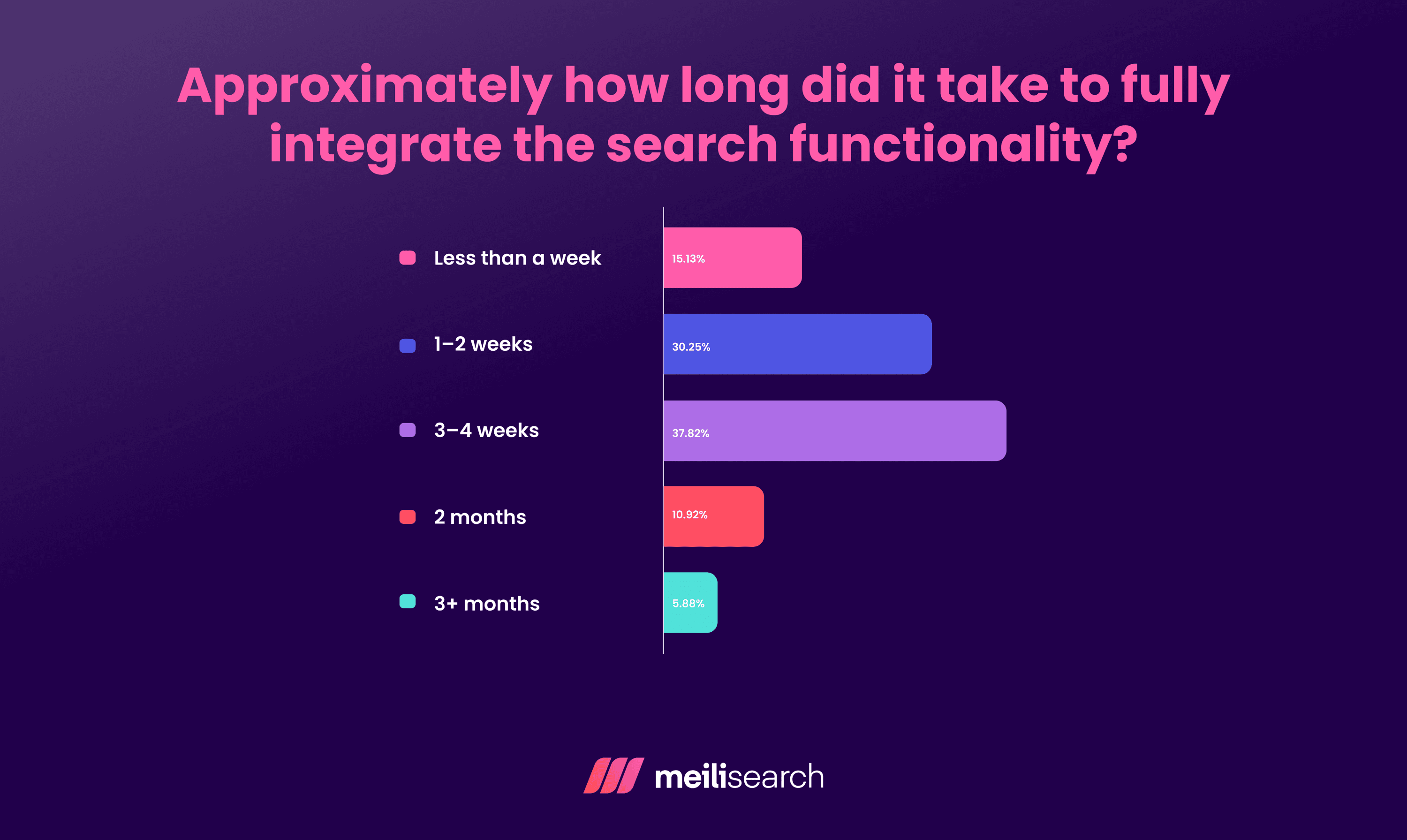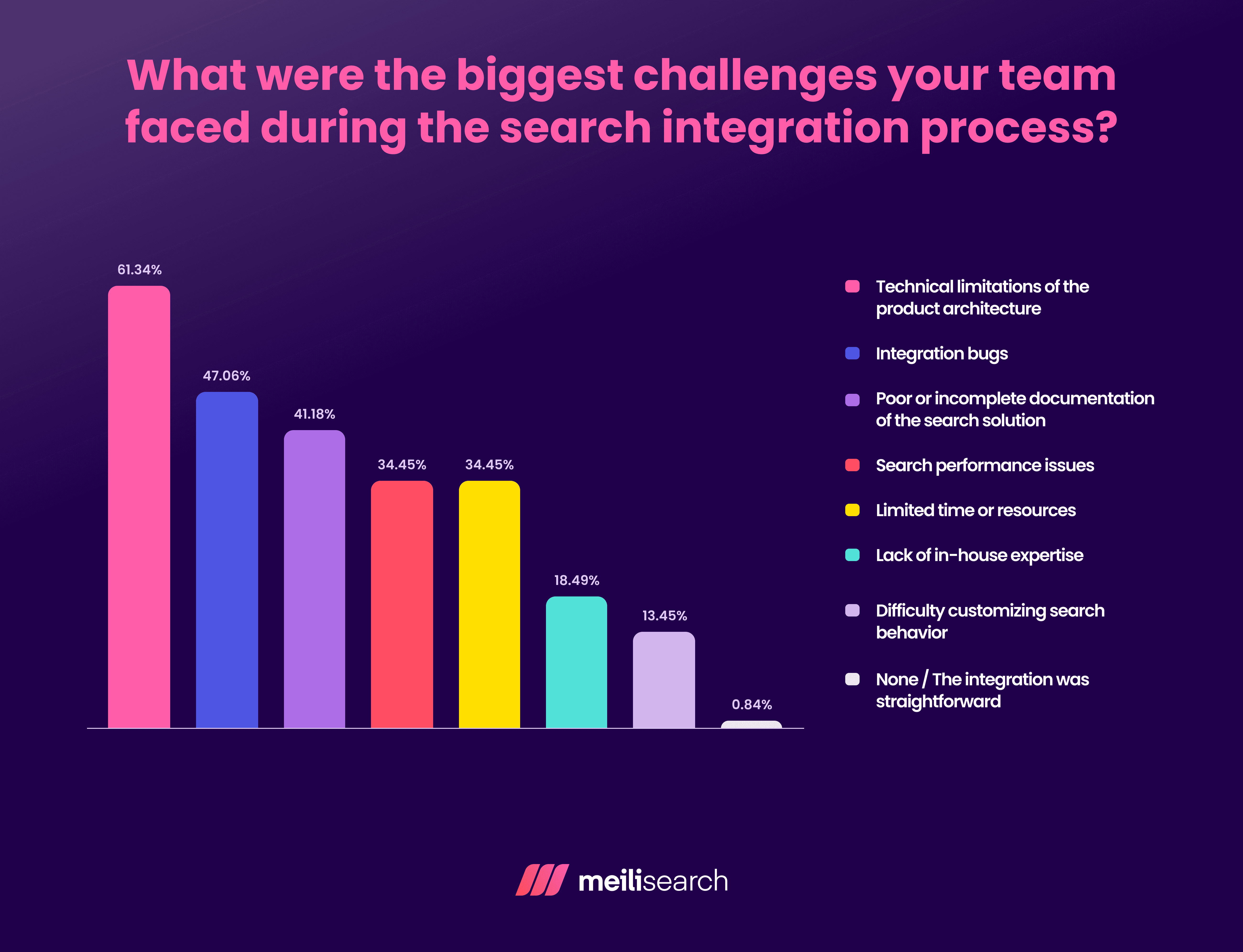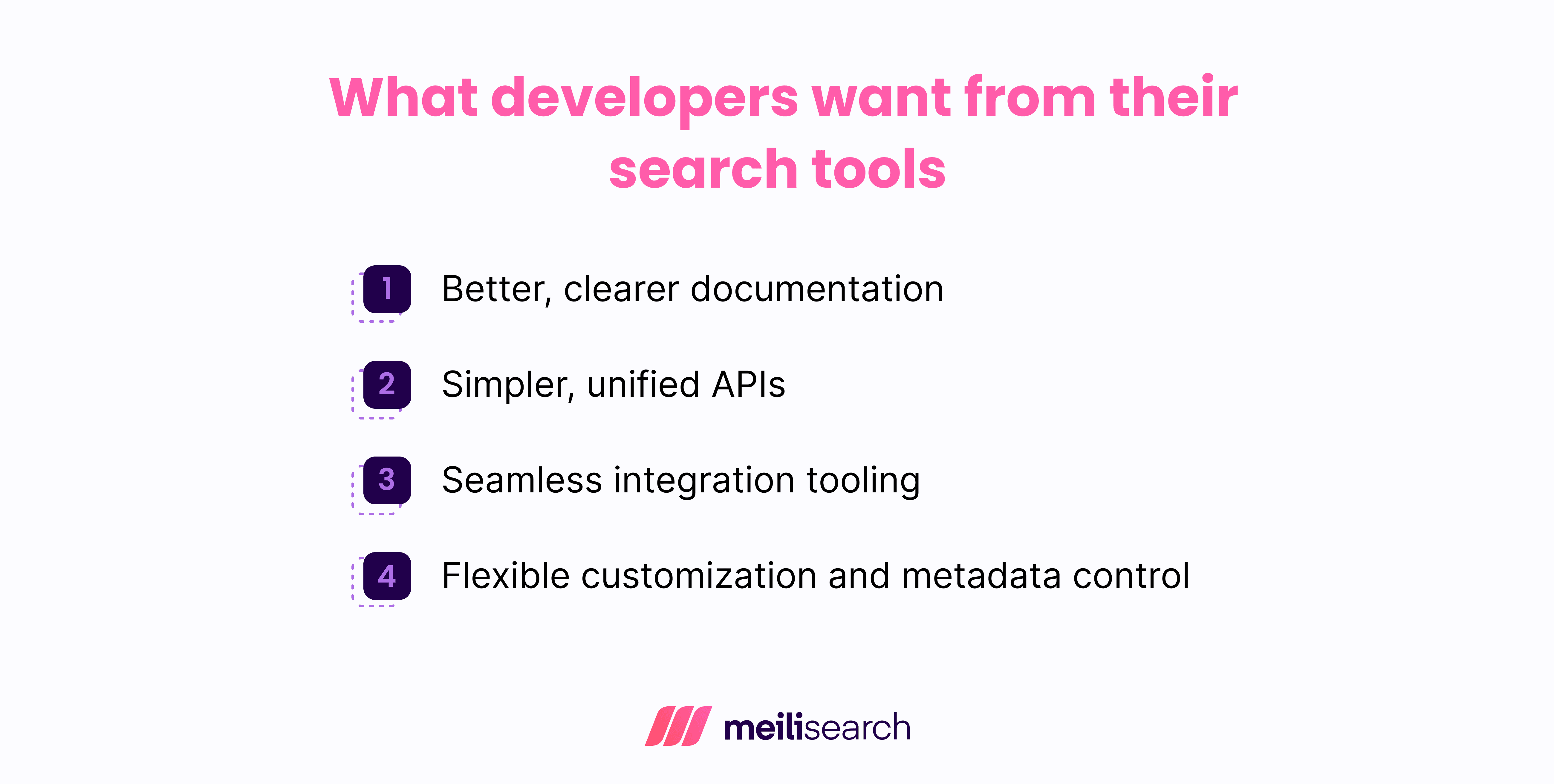We asked 100+ CTOs how long it takes to implement search. You're not gonna like the answer
Poor docs, technical debt, and high expectations: why search is still a tough build, according to 100+ technical leaders.

In this article
Most CTOs assume that implementing search is a quick, done-in-a-sprint kind of task. Something their dev team can figure out in a week.
But the truth couldn’t be more different. According to our survey, more than half (55%) of development teams require three weeks or more to roll out a search solution.
And they are the lucky ones. For some, it can take two or more months.
This begs the question: why is something as vital as search still so hard to get right?
We asked over 100 CTOs and technical CEOs to share what went wrong when implementing search and what they wish vendors would do differently. Their answer reveals common pitfalls and insights that can help you avoid the same costly mistakes.
Let’s dive into what they shared and how it applies to your own search initiatives.
Key insights (TL;DR)
- 86% of respondents called search ‘very important’ and ‘critical’ to their product’s user experience across industries like e-commerce, fintech, healthtech, edtech, etc.
- 55% of development teams spent three or more weeks implementing search. 17% struggled for two months or longer.
- The biggest blockers aren’t just bugs – they’re structural. The top three: inflexible tools (61%), broken documentation (47%), and a lack of expertise (34%).
- Less than 1% of respondents said integrating search was easy for them.
- During the implementation phase, the majority of teams turned to vendor documentation (55%) and support and customer success teams (49%) for help, while 20% relied on AI assistants like ChatGPT.
- Fast response time (71%), accurate results (51%), and the ability to handle typos or fuzzy matching (50%) are the top three features teams expect in their search experiences.
Insight #1: Most teams spent weeks – or months – on search implementation
According to our survey, only 15% of teams implemented search in under a week, while 55% took more than three weeks to do so.
For 17% of development teams, the process stretched to at least two months, resulting in a significant amount of wasted time.

These results reflect a consistent trend: integrating search has become a slow, resource-draining process for most teams.
In the open-ended answer section of our survey, one respondent even said, “Plan for double the time to implement.”
Users expect each search experience to be fast, accurate, and typo-tolerant by default. Giants like Google and Amazon have set high standards. Yet behind the scenes, devs are investing massive amounts of time just to get the basics working.
From our perspective at Meilisearch, that’s a costly baseline.
Insight #2: Search fails at the structural level, not just in the code
Less than 1% of respondents said that their search integration went smoothly.
When asked what slowed them down, they highlighted three most common issues:
- Technical limitations (61%): Inflexible infrastructure, clunky APIs, or the wrong tools often force teams to rethink and rebuild key systems.
- Poor documentation (47%): Missing or outdated documentation adds friction and guesswork into the process.
- Lack of expertise (34%): Many teams don’t have the experience to successfully implement search, leading to false starts and much trial and error.

While bugs and integration hiccups can cause short-term delays, the real problem comes from structural issues.
This means the architecture of the product wasn’t built with search in mind, the documentation is more of a hindrance than a help, and teams lack key skill sets to implement search properly.
The result is search that ships late, costs more, and becomes harder to maintain with every iteration.
Insight #3: When teams need help, the docs don’t always deliver
When search implementation gets tough – as it often does – what do teams do? They look for support.

The most common first stop is vendor documentation (55%), which ironically is the second biggest roadblock to implementing search, as noted in our previous insight.
Often, documentation is incomplete, outdated, or simply hard to navigate.
So, if the most relied-on source of guidance is also a leading pain point, it’s no wonder people get stuck for weeks.
Respondents also relied on vendor support or customer success teams (49%), online tutorials (48%), and peers or communities (e.g., Discord) (45%).
Almost one in five developer teams (19%) turned to AI tools, such as ChatGPT or Copilot, for help – a clear sign that AI tools are becoming an integral part of the troubleshooting stack.
Our survey findings show that support is fragmented. Developers chase answers across multiple sources, wasting time and energy as deadlines rapidly approach.
Insight #4: What developers really want from their search tools
Aside from the challenges, our team also asked technical leaders what they wished their search tools had done better.
Their answers focused on ways to save time, reduce confusion, and avoid frustration.

Better, clearer documentation
Teams want docs that go beyond the basics, with real-world examples and easy-to-follow setup steps to speed up integration.
Simpler, unified APIs
A common frustration is having to integrate multiple endpoints, so leaders are requesting unified APIs.
“Provide a single, well-documented API that can pull from multiple sources (documents, emails, chats, etc.) with consistent formatting,” one respondent said.
Seamless integration tooling
Teams want builders that work with popular frameworks and data pipelines, without spending too many hours on setup.
“*Make sure you find a platform that integrates well with other software development *[tools],” was a recurring sentiment among respondents.
Flexible customization and metadata control
Search isn’t a one-size-fits-all, so teams want more control over their ranking, filtering, and metadata display.
One respondent said: “Offering customizable filters and permission controls would help teams tailor search to their specific workflows.”
Respondents aren’t asking for the impossible. The idea is to make search implementation more straightforward, especially for teams working in fast-paced industries.
That’s why, at Meilisearch, we continually update our documentation, prioritizing a unified and straightforward API that anyone can understand.
Survey methodology and limitations
Our survey was conducted in July 2025 using SurveyMonkey’s paid Audience panel.
Respondents were decision-makers – CTOs, technical founders, or equivalent roles – at US-based software companies across all industries and company sizes.
To qualify, respondents had to pass two screening questions: one to confirm their technical leadership role and another to verify their experience with implementing search functionality.
This ensured we got answers from those with practical experience on the subject.
The survey included 11 questions in total (2 screening, 9 core), and we received 119 qualified responses. You can find complete data in this spreadsheet.
As with any data study, there are constraints. Responses may not fully represent large enterprises or heavily regulated industries, where search implementation challenges may differ.
Furthermore, the respondents were compensated by the SurveyMonkey platform for their participation, which may have introduced bias.
Finally, our mix of multiple-choice and open-ended questions provided quantitative and qualitative data, but may not have captured every nuance of the implementation process.
Search doesn’t have to be hard
The data paints a clear picture: search is needlessly complicated. Most teams spend weeks – even months – just to set up the basics, bogged down with technical hurdles and unclear guidelines that don’t meet real-world needs.
Technical leaders want vendors to go the extra mile, and that means offering simpler APIs, better documentation, and faster setup times.
In short, they want tools that respect their time and scale with their needs.
Why teams are turning to Meilisearch
Meilisearch is designed to address the exact problems identified in this survey: poor documentation, overwhelming complexity, and lengthy setup times. With a simple API, flexible customization, and clear guidelines, Meilisearch is precisely what product teams need, enabling them to set up and run powerful, scalable search easily.


